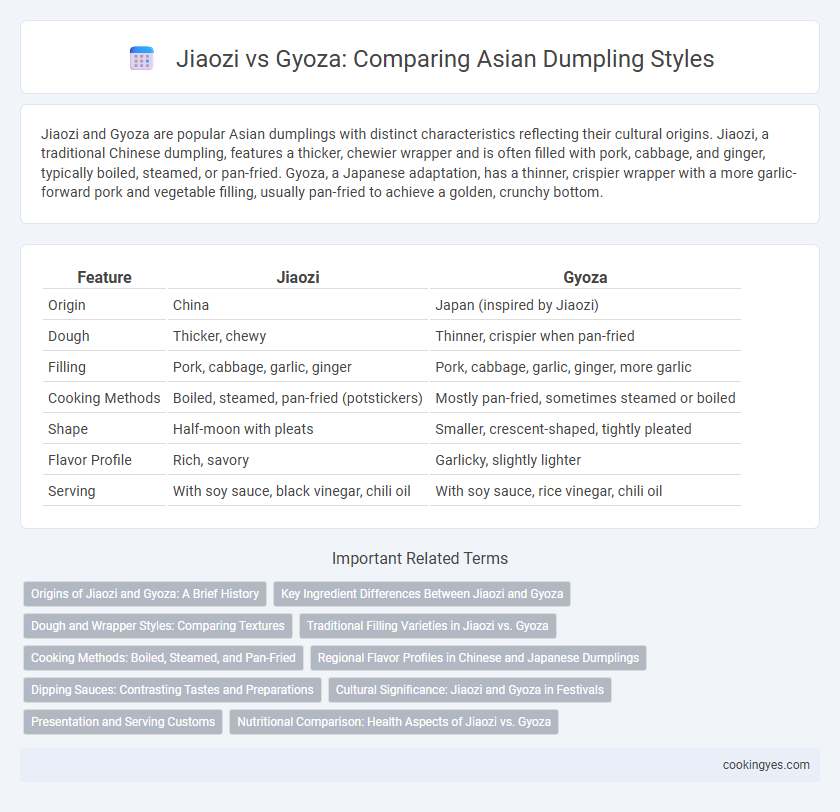Jiaozi and Gyoza are popular Asian dumplings with distinct characteristics reflecting their cultural origins. Jiaozi, a traditional Chinese dumpling, features a thicker, chewier wrapper and is often filled with pork, cabbage, and ginger, typically boiled, steamed, or pan-fried. Gyoza, a Japanese adaptation, has a thinner, crispier wrapper with a more garlic-forward pork and vegetable filling, usually pan-fried to achieve a golden, crunchy bottom.
Table of Comparison
| Feature | Jiaozi | Gyoza |
|---|---|---|
| Origin | China | Japan (inspired by Jiaozi) |
| Dough | Thicker, chewy | Thinner, crispier when pan-fried |
| Filling | Pork, cabbage, garlic, ginger | Pork, cabbage, garlic, ginger, more garlic |
| Cooking Methods | Boiled, steamed, pan-fried (potstickers) | Mostly pan-fried, sometimes steamed or boiled |
| Shape | Half-moon with pleats | Smaller, crescent-shaped, tightly pleated |
| Flavor Profile | Rich, savory | Garlicky, slightly lighter |
| Serving | With soy sauce, black vinegar, chili oil | With soy sauce, rice vinegar, chili oil |
Origins of Jiaozi and Gyoza: A Brief History
Jiaozi originated in Northern China during the Eastern Han Dynasty, renowned for its crescent shape and meat-vegetable filling, symbolizing wealth due to its resemblance to ancient Chinese gold ingots. Gyoza, inspired by Jiaozi, was introduced to Japan post-World War II and adapted with thinner wrappers and a richer garlic flavor, reflecting Japanese taste preferences. Both dumplings hold cultural significance, representing historical culinary exchanges between China and Japan while showcasing regional ingredient variations.
Key Ingredient Differences Between Jiaozi and Gyoza
Jiaozi typically features a thicker, chewier wheat-based dough, while gyoza wrappers are thinner and crispier, reflecting their Chinese and Japanese origins respectively. The filling in jiaozi often includes a mix of pork, napa cabbage, and ginger, whereas gyoza emphasizes garlic, green onions, and sesame oil for a more pungent flavor. These key ingredient differences contribute to the distinctive textures and taste profiles that define each dumpling style.
Dough and Wrapper Styles: Comparing Textures
Jiaozi dough is typically softer and thicker, made with wheat flour and water, resulting in a chewy and tender wrapper that holds fillings securely during boiling or steaming. Gyoza wrappers are thinner and made with a combination of wheat flour and sometimes oil, creating a delicate, slightly crispy texture when pan-fried. This difference in dough thickness and composition directly influences the overall mouthfeel and cooking method preference between Chinese jiaozi and Japanese gyoza.
Traditional Filling Varieties in Jiaozi vs. Gyoza
Traditional Jiaozi fillings commonly feature a blend of ground pork, napa cabbage, and ginger, reflecting northern Chinese culinary influences. In contrast, Gyoza fillings emphasize finely minced pork, garlic chives, and cabbage, inspired by Japanese adaptations of Chinese jiaozi. Both dumpling styles highlight regional preferences in seasoning and ingredient texture, shaping their unique flavor profiles.
Cooking Methods: Boiled, Steamed, and Pan-Fried
Jiaozi and Gyoza are two popular types of Asian dumplings distinguished by their cooking methods: jiaozi is traditionally boiled or steamed, resulting in a soft, tender texture, while gyoza is commonly pan-fried to achieve a crispy bottom and juicy interior. Both styles can be steamed or boiled, but pan-frying is the signature technique of gyoza from Japanese cuisine, enhancing the dumpling's flavor through caramelization. The choice between boiling, steaming, or pan-frying affects the dumpling's texture and taste, highlighting the distinct culinary traditions behind jiaozi and gyoza.
Regional Flavor Profiles in Chinese and Japanese Dumplings
Jiaozi, traditional Chinese dumplings, often feature a thicker, chewy wrapper with fillings like pork, cabbage, and chives, reflecting northern China's hearty and savory flavor profiles. Gyoza, the Japanese adaptation, typically has a thinner, crispier skin, filled with finely minced pork, garlic, and cabbage, emphasizing subtle umami and a hint of sweetness characteristic of Japanese cuisine. Regional seasoning variations include jiaozi's use of ginger and soy sauce versus gyoza's preference for garlic and sesame oil, highlighting the distinct culinary identities within Asian dumpling traditions.
Dipping Sauces: Contrasting Tastes and Preparations
Jiaozi dipping sauce typically combines soy sauce, vinegar, and minced garlic or chili oil for a balanced, tangy, and savory flavor profile that complements the tender, chewy dumplings. Gyoza dipping sauce emphasizes a sweeter and milder taste with a mixture of soy sauce, rice vinegar, and a touch of sesame oil, enhancing the pan-fried dumpling's crispy texture. The contrasting sauces reflect regional preferences, with jiaozi favoring bold and pungent notes, while gyoza offers a subtle, fragrant accompaniment.
Cultural Significance: Jiaozi and Gyoza in Festivals
Jiaozi hold profound cultural significance during Chinese Lunar New Year celebrations, symbolizing wealth and prosperity due to their gold ingot shape. Gyoza, while inspired by Jiaozi, play a central role in Japanese festivals like the Gyoza Festival in Utsunomiya, showcasing regional pride and culinary craftsmanship. Both dumplings embody cultural heritage and communal bonding through festival traditions that emphasize family unity and local identity.
Presentation and Serving Customs
Jiaozi are traditionally served boiled or steamed with a focus on simplicity and communal sharing, often accompanied by soy sauce and vinegar dipping sauces in a shallow dish. Gyoza typically feature a pleated crescent shape and are pan-fried to achieve a crispy bottom, served individually on plates with a side of tangy soy-based dipping sauce enriched with garlic or chili oil. The presentation of gyoza emphasizes textural contrast, while jiaozi highlight family-style dining customs with larger quantities arranged on communal platters.
Nutritional Comparison: Health Aspects of Jiaozi vs. Gyoza
Jiaozi and Gyoza share similar ingredients but differ in nutritional content due to variations in cooking methods and fillings. Jiaozi often contains lean pork and vegetables, offering a balanced mix of protein and fiber with lower fat content when boiled, while Gyoza typically includes a higher fat percentage from pan-frying, increasing calorie density. Both dumplings provide essential nutrients, but Jiaozi is generally a healthier option for those seeking lower fat and calories, whereas Gyoza offers richer flavor with slightly higher fat levels.
Jiaozi vs Gyoza for Asian dumpling style Infographic

 cookingyes.com
cookingyes.com